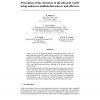BC
2010
14 years 1 months ago
2010
We have previously tried to explain perceptual inference and learning under a free-energy principle that pursues Helmholtz's agenda to understand the brain in terms of energy ...
BC
2004
14 years 3 months ago
2004
It is known that the springlike properties of muscles provide automatic load compensation during weight bearing. How crucial is sensory control of the motor output given these basi...
NIPS
2003
14 years 5 months ago
2003
Is there a way for an algorithm linked to an unknown body to infer by itself information about this body and the world it is in? Taking the case of space for example, is there a w...
ESANN
2006
14 years 5 months ago
2006
We investigate when sparse coding of sensory inputs can improve performance in a classification task. For this purpose, we use a standard data set, the MNIST database of handwritte...
ECAL
2007
Springer
14 years 5 months ago
2007
Springer
In robotics, exogenous fault detection is the process through which one robot detects faults that occur in other, physically separate robots. In this paper, we study exogenous faul...



